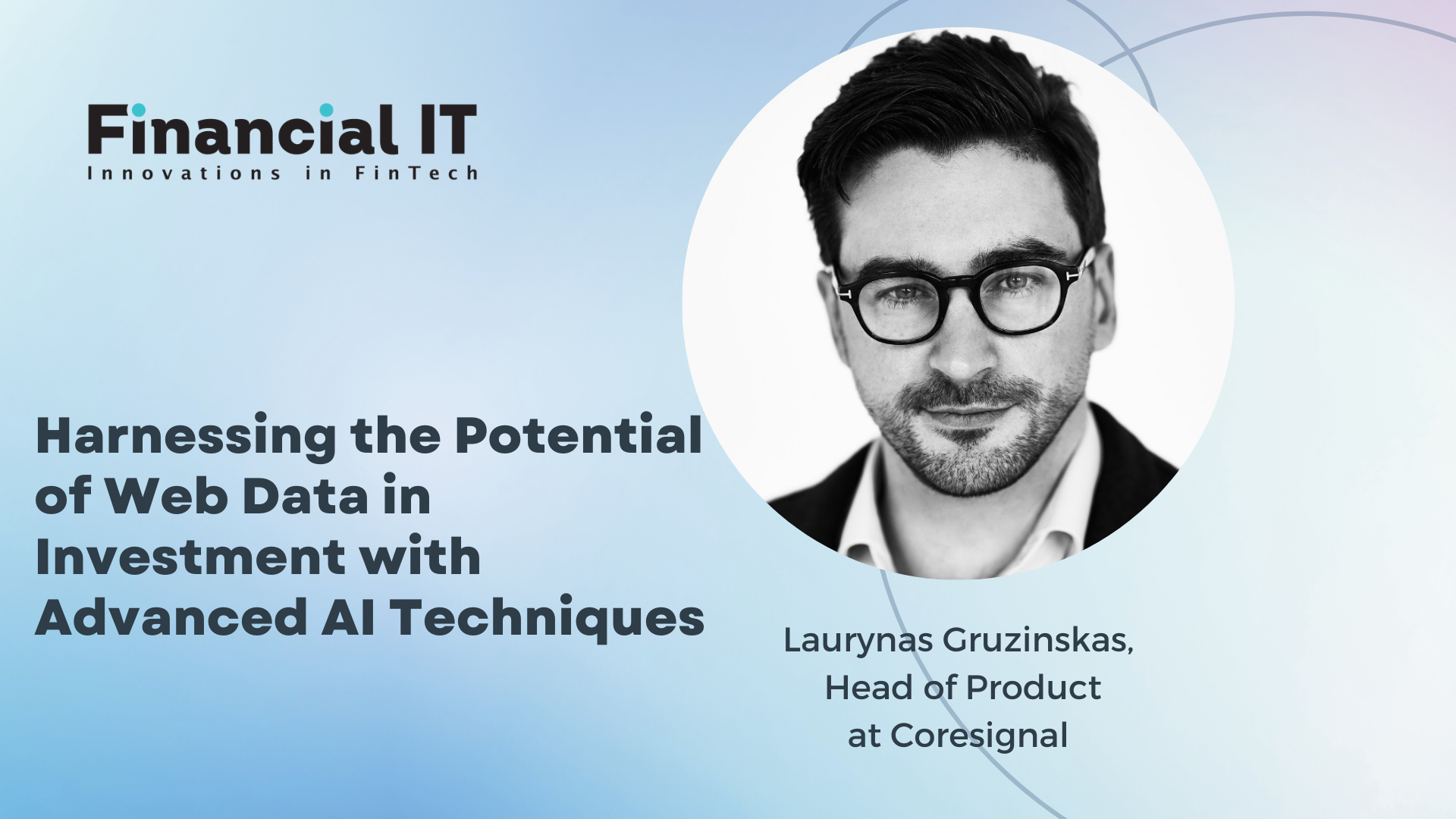Harnessing the Potential of Web Data in Investment with Advanced AI Techniques

- Laurynas Gruzinskas, Head of Product at Coresignal
- 26.02.2024 12:15 pm #AI #webdata #venturecapital #riskmanagement #aitools
In today's data-centric landscape, the web is a goldmine of information.
From social media posts to funding information, every digital interaction possesses the potential to yield valuable insights. Yet, often this data remains unexplored.
With the merging of AI and web data, you can uncover investment secrets that otherwise could escape your line of sight.
Let's delve deeper into this fascinating synergy.
AI and web data: a symbiotic relationship
Navigating through the insane amounts of data that are being generated every day is not something that a human being could cover.
It’s possible to reap certain benefits from a smaller scale of data, but when you need insights from billions of data records, you should think about AI solutions to help you out.
Here are some of them:
Natural language processing (NLP). One of AI's premier tools, NLP, delves into textual data, making sense of job descriptions, news articles, and social media posts. With NLP, we can gauge sentiment, derive context, and prepare data that could later be used to train specific predictive models.
Predictive analytics. This is where AI truly shines. It learns patterns from the past and then you can use this model by feeding current data to it in order to make future predictions. AI can make surprisingly accurate predictions about market moves, company health, and investment potential.
Reinforcement learning. As they're fed more data, these models refine their predictions, making them sharper and more accurate over time. It’s a continuous loop of learning, adjusting, and predicting.
Examples of AI’s capabilities in investing
To truly appreciate the transformative power of AI in decoding publicly available web data for investment insights, we need to witness it in action.
By diving into real-world scenarios and examples, we can understand how AI's advanced algorithms and pattern-recognition capabilities meld with vast amounts of web data to produce actionable investment intelligence.
Venture capital
For a venture capitalist, spotting the next big thing is paramount. A budding tech company, through its web data footprint, might reveal they're investing heavily in R&D.
Simultaneously, social media sentiment analysis might indicate positive reception to their beta products.
When AI integrates these data points, it can flag the startup as a high-potential investment.
Usually, VC firms try to build a clear company score that covers more angles than a basic assessment. And the integration of multiple data points can help venture capitalists create the score that will define their eagerness to invest.
Private equity
Let's take a mature manufacturing firm that has predominantly operated domestically. Recent data showcases exploratory surveys in international markets, coupled with a spike in hires with multilingual capabilities.
AI can pick up these cues, suggesting the company is poised for international expansion and might be ripe for investment.
The edge AI brings to investment strategies
When it comes to investing, every step, every decision holds consequences. As markets evolve, so does the need for advanced tools to navigate its complexities.
Enter AI, a revolutionary force that is reshaping the contours of investment strategies. While traditional methodologies depended largely on past data and human intuition, AI introduces dynamic adaptability, foresight, and precision into the mix.
It's not merely about analyzing available data, but about understanding the broader implications of this data, predicting future trends, and swiftly responding to market fluctuations.
Whether it's offering a lens into future market shifts or vigilantly monitoring the health of investments, AI is fast becoming an indispensable ally for investors.
Below, I dive deeper into the multifaceted advantages AI offers.
Real-time analysis. In the world of investment, timing is everything. The global market is akin to a river, always moving, always changing. AI stands on its banks, providing instantaneous analysis, ensuring that investors are always a step ahead and no potential investment opportunity slips through the cracks.
Risk management. The waters of investment are replete with potential pitfalls. AI, with its advanced pattern recognition capabilities, serves as a vigilant lifeguard. It can alert investors to potential red flags, be it erratic company behavior, financial inconsistencies, or subtle shifts in market sentiment that might otherwise go unnoticed.
"As web scraping allows to collect enormous amounts of publicly available data on companies nowadays, humans can not physically process that data in reasonable amount of time. And that is the biggest advantage AI brings here. No matter what kind of models you decide to build and use, their ability to interpret data in a matter of seconds gives you the ability to get flags/signals about important movements in the market/company, and can help you to make the decisions fast and before your opponents," says Jurgita Motus, Senior Data Analyst at Coresignal.
The limitations of AI
The advent of AI in investment has undeniably transformed the landscape, offering sharper tools and deeper insights than ever before.
However, like any tool, its efficacy is dependent on how it's wielded. The allure of AI—its speed, its vast analytical capabilities—can sometimes overshadow its inherent limitations.
Here's a closer look at the need for a balanced perspective when incorporating AI into investment strategies:
Understanding AI's scope. At its core, AI is a sophisticated data-processing tool. It analyzes based on the data it's fed and the algorithms it's designed upon. While it can recognize patterns and make predictions, it lacks the human faculties of intuition, empathy, and cultural awareness. Thus, while AI might predict a stock's rise based on past data, it might not account for externalities like socio-political factors or sudden market disruptions.
The danger of over-reliance. Entrusting AI with complete decision-making autonomy can be perilous. There's a phenomenon called "overfitting" in machine learning, where a model might perform exceedingly well on training data but fail to generalize on new, unseen data. In the context of investment, this could mean a model that's too attuned to past market behaviors and misses out on new emerging trends.
Human intuition & expertise. AI can process vast amounts of data at lightning speed, but it doesn't "understand" this data in the way humans do. A seasoned investor might pick up on nuances—a CEO's tone during an earnings call, the implications of a geopolitical event, or the potential ripple effects of a new policy—that an AI model might overlook. Merging AI insights with human intuition creates a synergistic approach that leverages the strengths of both.
Ground-reality checks. There's a world beyond the data. For instance, while AI can analyze a company's financial health and market sentiments, it can't physically inspect a company's operations or gauge the morale of its employees. Due diligence, which often requires on-ground research, interviews, and firsthand observations, remains an integral part of the investment process.
Integration with traditional methods. It's important to remember that AI is an addition to the investor's toolkit, not a replacement. Traditional research methodologies—industry reports, expert opinions, and market analysis—still hold immense value. Integrating AI-driven insights with these time-tested methods provides a holistic view, allowing for comprehensive and informed investment decisions.
"As AI is evolving enormously, it is very important not to be blinded by it's capabilities. It can not be left on its own to make final decisions, and various AI models along their predictions should be taken into account as just another signal or flag alongside others. The very last decision still should be made by a human being," Jurgita pointed out.
While AI serves as a powerful compass in investment, it should be navigated with caution, always complemented by human judgment and expertise.
An optimal investment strategy lies in the confluence of AI's computational prowess and the discerning eye of a seasoned investor.
What lies ahead for AI and web data in investment
In the dynamic tapestry of finance and technology, the interplay between AI and web data is emerging as one of the most exciting threads.
While the initial touch has proven transformative, we're standing at the precipice of even greater breakthroughs. As we gaze towards the horizon, the potential is unprecedented.
Let's delve deeper into the promising future that lies ahead.
Evolution of AI models
Modern AI models are continually evolving. With advancements in deep learning, neural networks, and other AI architectures, the capability to process and understand web data is becoming more refined.
However, it’s not safe to say that AI models will boast enhanced interpretability, at least not in the near future. As models are getting bigger and more complex, it becomes a lot harder to understand why it makes certain decisions.
It's very unclear what data was fed into the model and how it changed since then, so understanding the real sentiment is hard and cannot be taken as an objective fact.
Explosion of web data
With every click, every online transaction, and every digital interaction, the volume of web data is ballooning. As we move further into the digital age, this proliferation will only intensify.
For investors, this means a deeper well of information from which to draw insights, spanning not just companies' official communications, but also data from forums, blogs, and social media.
Incorporation of diverse data streams
Beyond traditional web data, the future will see a confluence of diverse data streams in investment analysis.
Geospatial data, which provides insights into physical locations and movements, can offer clues about retail trends or the growth potential of real estate.
Data from IoT devices, ranging from smart home gadgets to industrial sensors, can offer real-time insights into consumer behaviors and industry trends.
Enhanced real-time analysis
With the rapid evolution of AI capabilities, the lag between data generation and data analysis will shrink.
Real-time analytics, powered by edge computing and efficient algorithms, will allow investors to make more timely and informed decisions.
Predictive forecasting and scenario modeling
AI's potential to predict future market trends based on vast datasets will grow. Beyond forecasting, AI will also enable sophisticated scenario modeling, allowing investors to simulate various market conditions and make proactive strategies based on different potential outcomes.
Improved risk management
With the integration of diverse data sources, risk management models will become more comprehensive.
AI will be better equipped to detect anomalies, assess the volatility of certain investments, and provide more detailed risk-reward analysis.
Ethical and regulatory evolution
As AI takes on a more significant role in investment decisions, there will also be a parallel evolution in ethical considerations and regulatory frameworks.
Ensuring the responsible use of AI, data privacy considerations, and setting boundaries on AI's role in high-stakes financial decisions will become central topics of discussion.
The fusion of AI and web data heralds a paradigm shift in the area of investment.
As the tapestry continues to evolve, investors equipped with these advanced tools will be better positioned to navigate the complexities of the market.
While challenges remain, the future is undeniably brimming with opportunities, awaiting those who dare to innovate and integrate.
Conclusion
In the evolving realm of investment, the confluence of web data and AI is the next frontier. With AI, the vastness of the web transforms from an impenetrable jungle into a mapped, organized cityscape.
And those who are ready for this synergy, will be able to tackle investment with more precision, more information, and more chances of success.





















